Driving Into a New Morning
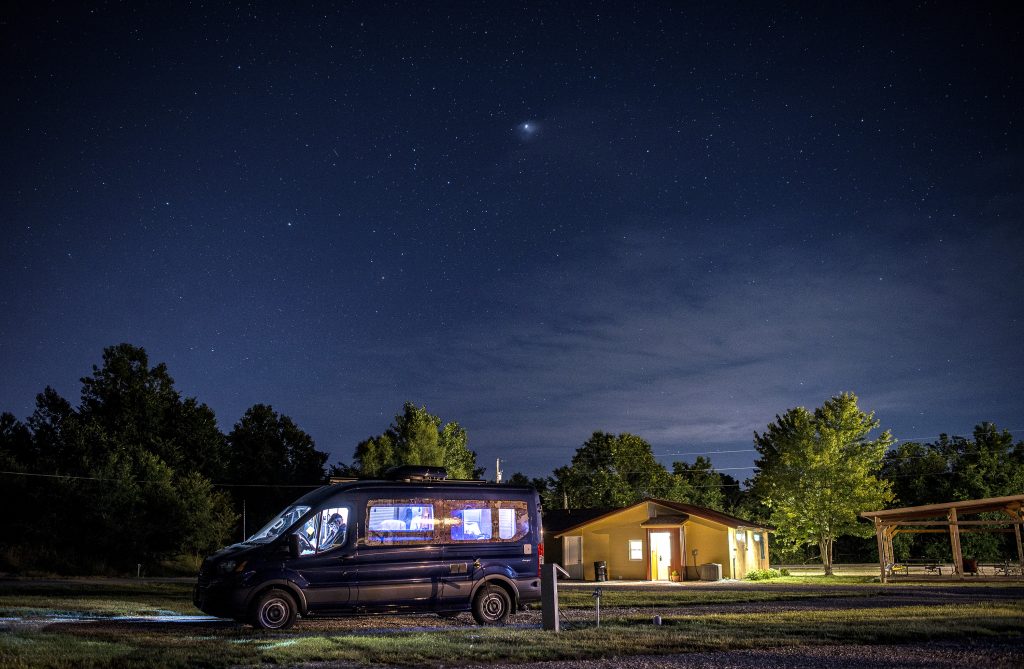
Camp Mi Casa, Old Route 66, Carthage, MO,. (Jon Sall photograph)
Like a broken needle in a compass, selling my camper van left me lost in the slipstream. The blue converted 2015 Ford Transit van was the subject of 2018’s “The Camper Book (A Celebration of a Moveable American Dream)”with fine photographs from Jon Sall and a great foreword from actor-Detroit Tigers fan Jeff Daniels.
The van became a 10-year chapter of my life.
While looking back at the book and photos we took along the way, I arrived at the “what was I thinking?” moment. The van was likely a whiplash response to the passing of my parents, leaving the Chicago Sun-Times and buying a foreclosed house with a driveway to park the van. And who knew the ranch house belonged to my parents when I was born in Berwyn? You might have wanted to take a long trip, too.
You want someone waiting for you when you come home.
Over the weekend, I removed the memory magnets that I had gathered during my 24,222 miles between June 2016 and March 2017 while assembling the book. It connected me with a distant time. Many common threads of America began fraying on January 20, 2017, the day of the inauguration.

Trail of magnets from an American journey.
The van visited the Iowa State Fair, the Big Texan in Amarillo, TX., Merle Haggard’s favorite diner in Redding, CA., a ferry ride to Washington Island, WI., Deer Isle, ME. (not far from where John Steinbeck began Travels With Charley” in his camper van, Salinas, Ca. (where we visited Steinbeck’s “Rocinante” camper van.), Coeur d’ Alene, ID., Ocean Lakes in Myrtle Beach, SC.. the Flora-Bama in Pensacola, FL, Alvin & Charlie’s gay campground in Eureka Springs, AR (you’ll have to read the book), Worlds of Fun in Kansas City, Mo. and more. We even did a couple of van remotes for my WGN-AM show including this one from FitzGerald’s in Berwyn with singer-songwriter Curtis McMurtry.
The fun in all those wanderings eases some of the regret in parting with the van. At least I won’t pull a Haggard and adjourn to my van to die as he did in his beloved Santa Fe Railroad-inspired tour bus where we once drank shots of whiskey together. (Check out Chris Scruggs’ fine YouTube interview.)
The van sold at 69,500 miles. No accidents. No dents. No regrets, except for the fact that I never took the van to a drive-in movie. There are many things I do alone. That is not one of them. The book remains something I am proud of in terms of photography, cool design, and the editing of Lisa Reardon. The van is just a thing. The book is an idea that will last forever.
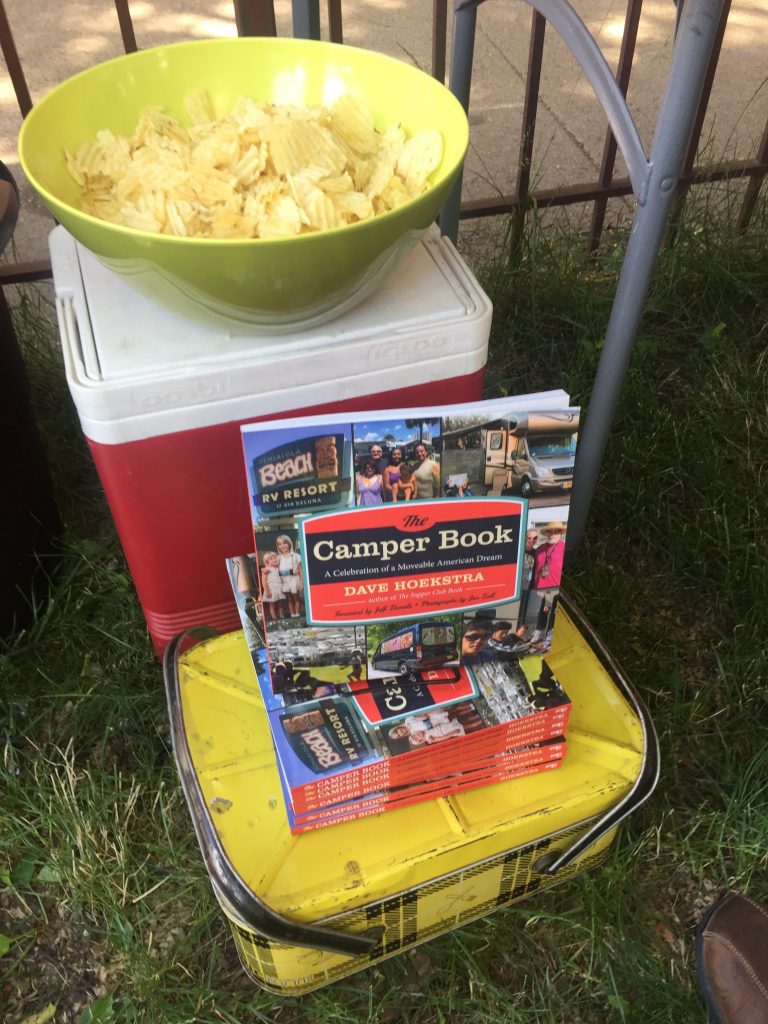
Book party at Komoda in Ukranian Village, Chicago. Thanks Sherri!
The van was on the market for less than a week before it was discovered by Sherryl and John of Cedar Lake, IN. They are in their mid-60s.
John liked the van’s bed as a place to rest. Sherryl is a photographer, writer, and pension administrator. She volunteers in The Museum at Lassen’s Resort in Cedar Lake. They want to write, travel and take pictures. As reader Paul Halvey wrote in my “Changing Lanes” post, “Do nothing. When the van is ready the buyer will appear.”
Before the sale Sherryl sent me a poem about the van. Part of it goes like this:
…..Built with custom comfort, enough but not too much
it helped me tell my stories and kept the world in touch
That van is getting older; it’s aging just like me
with so much life inside it, I need to set it free
So, I found a new beginning, where its past will stay alive
A new home to make new memories and start a brand-new drive….”
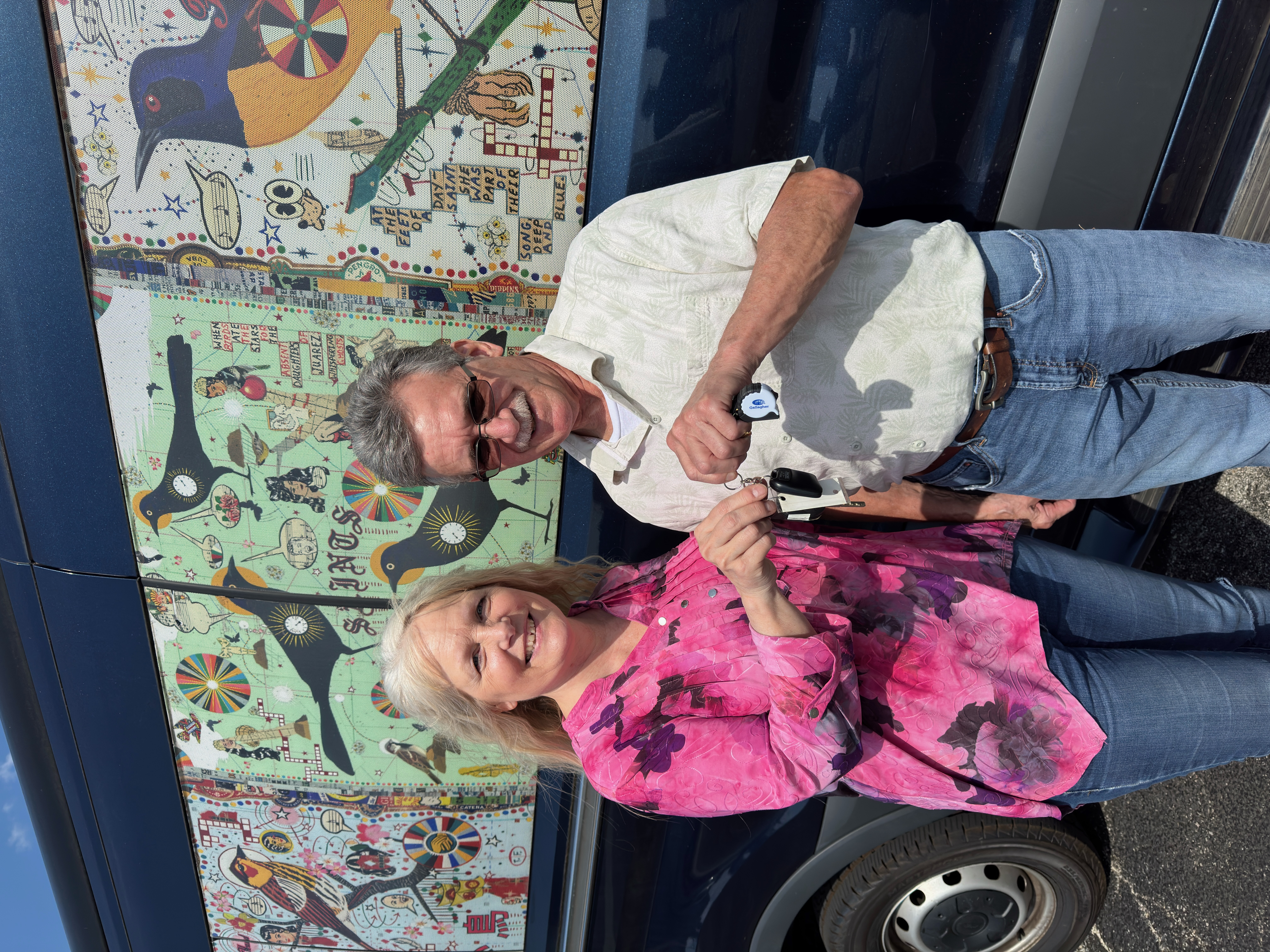
Passing it on to Sherryl and John. (Jon Sall photo.)
Sherryl and John inspected the van on July 2 in a designated spot at the Tinley Park police station. They took it for a test drive. John looked like former Bears coach Dave Wannstedt.
After the transaction, I asked them a few questions. “We’re not campers, really,” Sherryl said. “We’re family. And John’s family is in (Central) Lockhaven Pennsylvania. That’s a haul. We have a 2009 Traverse. We’ve done it with a little car and three kids. We always wanted a van. Then when John became disabled it became so much harder for him to be stuck in a car and not move or stretch.”
John worked for 30 years at chemical facilities in Chicago’s south suburbs. He was terminal manager, running the tank wash at Dana Tank Container in Summit. Physical work included moving 55 gallons of drums filled with chemicals and cleaning vats and steam tanks.
John has endured two reverse shoulder replacements, a spinal fusion, a hip replacement and a knee replacement. He became disabled in 2004. It took Sherryl and John two years and miles of paperwork to obtain Social Security disability.
“Regulations changed over the years,” he said. “Fumes. The chemicals you’re working with. It was dangerous work. It sunk into the joints. My bones are bad.” Sherryl said, “The doctor said he can’t prove it but he thinks the chemicals did that to him. His brother worked at DuPont near Louisville and he has degenerative disease.”
John looked around the quiet police station lobby. He gathered his thoughts and said, “It was very depressing. When you worked your whole life, seven days a week, work, work, work. You gotta’ work hard for the future. You look ahead for your kids and family. Then stuff happens and you can’t work anymore.”
Sherryl remembered that John was considered too young for his first spinal fusion in his 40s. “But when they went in they said he had the bones of an 80-year-old man,” she said.

Visiting remnants of the New Orleans Times-Picayune building April 29, 2019.
“Our thing was that we were going to do the things we wanted to do with our kids, our family and home. Get a pension and travel. We changed that a little bit. Go do it now because you never know what’s going to happen to your body and whether you can travel.
“John wakes up every two hours because he is in pain so you have to adjust to get out of the pain. We need something where he can lay down in comfort. And I’m not getting any younger. I’ve rolled foam into the backs of our cars to make beds back there.”
Sherryl is the funds administrator for Beer Industry-Local Union No. 703 in Tinley Park, formerly at Ashland and Jackson in Chicago. She used to commute from Cedar Lake to Chicago on one-way trips that could take as long as three hours in dicey weather. Yes, she likes to drive.
In recent times, Sherryl has given her pensioners some advice. “They don’t know if they can retire,” she explained. “I say, ‘Okay, you work to the age and the date. You get used to that income and while health care is the biggest thing you can’t get it to save your life. But I tell them, ‘If you can retire, retire.” I’ve written that, too: don’t postpone joy.
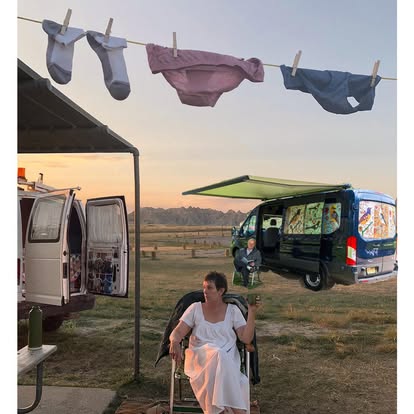
When I paid tribute to the film “Nomadland.”
John and Sherryl were married in 1986. They met at a New Year’s Eve party in 1983 at the Poison Apple nightclub in Lynwood, IL. They honeymooned in the Pocahontas. They have three kids between 29 and 34. Ashley is a graphic design artist, Sarah Jessica is an artist, and John Wayne, Jr. is a marine. They also have two grandchildren. “They don’t know we’re doing this,” Sherryl said.
Jon Sall knew how difficult it was for me to part with the van. I was mired in an incomplete sadness. I still drive by my parents’ house now and then. I’m a sucker for songs about moving, like Tom Waits “Ol’ 55” with the stars beginning to fade. Jon pointed out that we are just custodians of our favorite vehicles. I’m sure the van will continue to smile in another form like Bob Waldmire’s 1972 Volkswagen microbus in the Pixar/Disney film “Cars.”
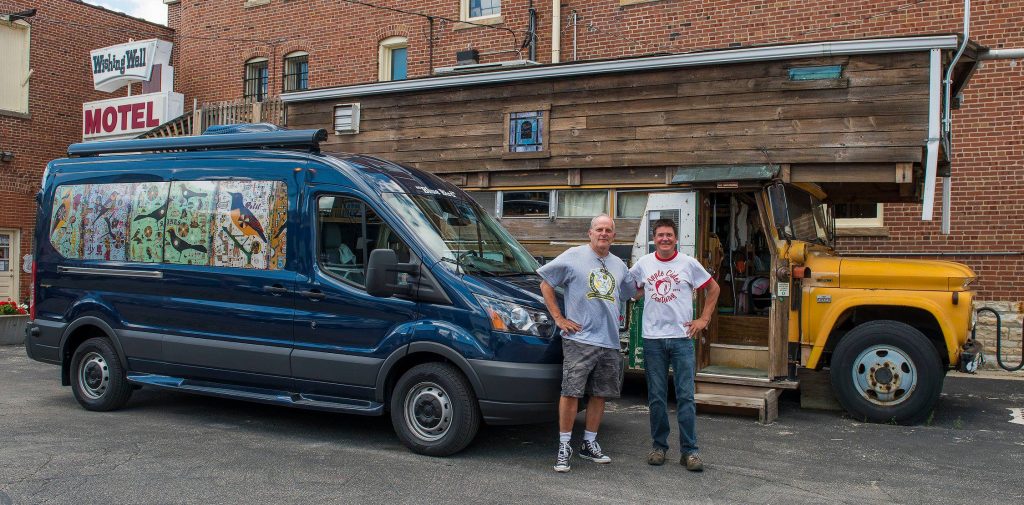
Dave and Jon Sall (right) launching the trip at the Route 66 Hall of Fame and Museum in Pontiac, IL
What would I tell John and Sherryl?
Follow the road to something real.
Like my other books about supper clubs and civil rights soul food restaurants, sense of place was a thesis of “The Camper Book.” But in this case, “place” was transient. When I feel lost, I check in with 1995’s “House As a Mirror of Self,” by Clare Cooper Marcus. The foreword is from James Yandell, former president of the C.C. Jung Institute of San Francisco. He writes, “What is not yet conscious is normally experienced “out there,” in projection on the outer world. We find ourselves in other people, things, and places, in experiences felt to come from the outside. Only secondarily, if at all, do we recognize our own participation in our experience. When we do, we have a chance to reclaim the projection, ponder it, own it, and add it to an awareness of ourselves.”
That was the “out there” magic of my van, but it can be the beauty of travel for anyone. I may be too old to drive an all-nighter but I will still travel. The spirit endures. There are still many good things out there. And I am happy that John and Sherryl are happy.
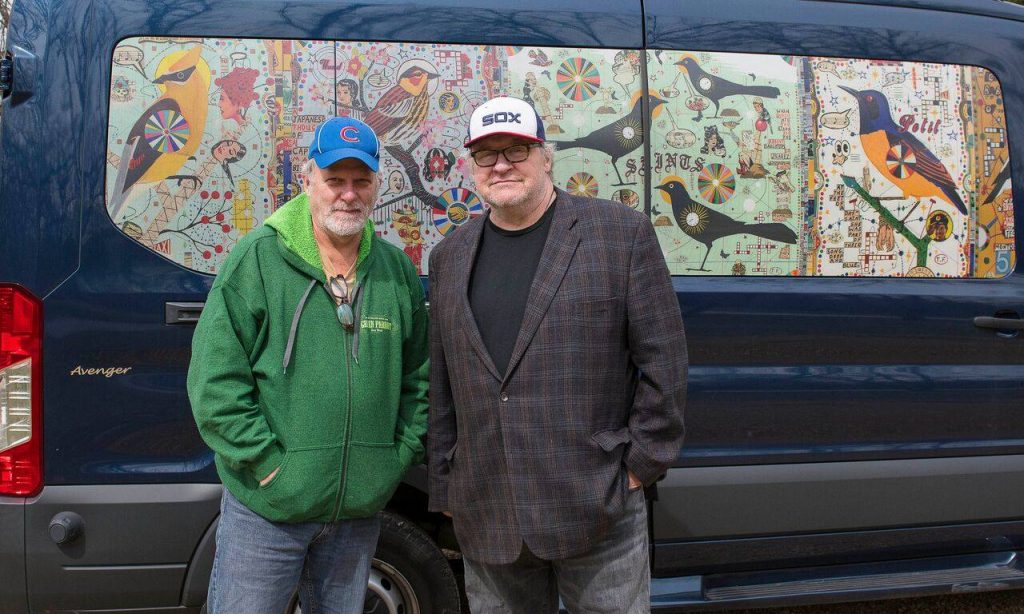
Dave and Chicago artist Tony Fitzpatrick (Sox cap) at Morton Arboretum, 2016. (Wendy Love photo)
The van is gone, but I still have my basement tiki bar. I don’t have to pay tolls and there are no potholes on the way. While unpacking the van I thought of the friends and family with van-warming gifts. The birds of Tony Fitzpatrick that blessed the exterior wrap. The guidance from Tom O’Neill who found the original Ford Transit van in St. Louis. The mousepad and support from my brother Doug. And Jon, who was beyond generous with his time, knowledge, photography, and positive spirit.
Now it’s time to start looking for a boat.

Somewhere in America. (Jon Sall photograph.)

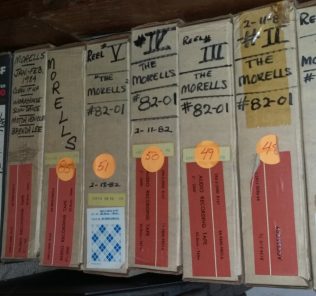
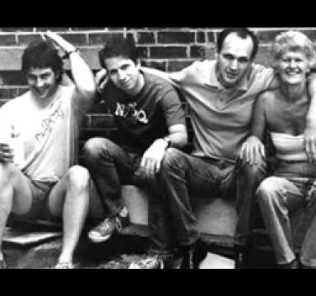
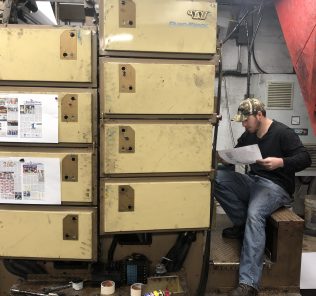
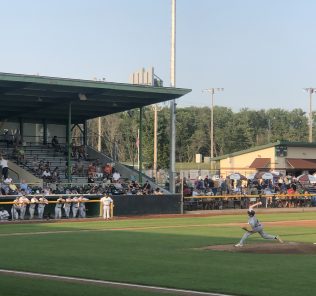
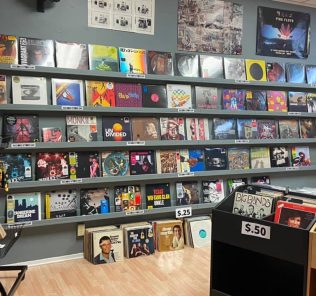
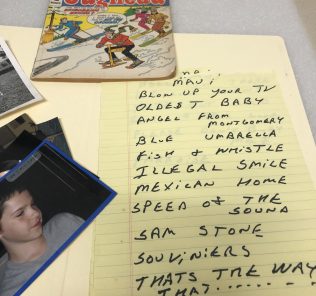


Leave a Response